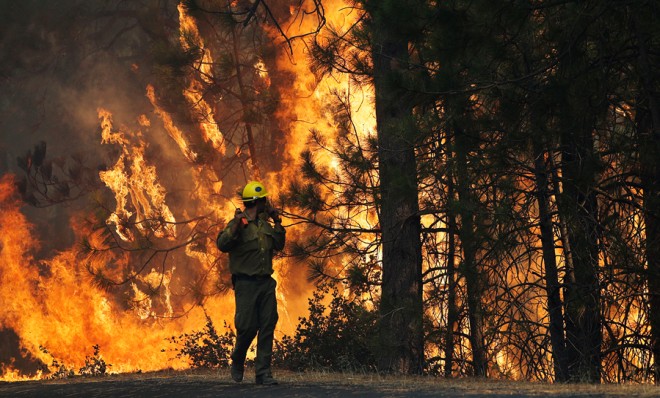Why huge wildfires are the 'new normal'
Climate change isn't the only culprit


California's Rim Fire has scorched 281 square miles, making it the seventh biggest wildfire in the state's history. And the blaze is still only 20 percent contained, so firefighters warn its toll will only get worse.
"It's burning its way into the record books," Daniel Berlant, a spokesman for the California Department of Forestry and Fire Protection, tells the Los Angeles Times.
The fire has blackened tens of thousands of acres in Yosemite National Park, threatened to disrupt water and power supplies to San Francisco, and destroyed 111 buildings, despite the efforts of 3,700 firefighters to bring it under control.
The Week
Escape your echo chamber. Get the facts behind the news, plus analysis from multiple perspectives.

Sign up for The Week's Free Newsletters
From our morning news briefing to a weekly Good News Newsletter, get the best of The Week delivered directly to your inbox.
From our morning news briefing to a weekly Good News Newsletter, get the best of The Week delivered directly to your inbox.
There is something even scarier than the massive fire's path of destruction, though. Fire and forestry experts say that a host of factors are conspiring to make this kind of massive blaze far more common in the future.
"This is the new normal," Don Wuebbles, a professor of Atmospheric Sciences at the University of Illinois, tells National Geographic. "If we look at how the climate has changed over the past 50 years — with warmer temperatures increasing beyond what we used to see in the early part of the 20th century, and changes in precipitation — fires will continue to happen and get worse and worse."
United States Forest Service Chief Thomas Tidwell testified in a June Senate hearing that the average wildfire burns twice as much land today as it did 40 years ago. In the last decade, 10 states have experienced their worst fires ever, and the cost of fighting fires has jumped from $1.1 billion in 1994 to $2.7 billion in 2011. Warmer weather is also causing fires to burn over a bigger chunk of the year. "The line separating "fire season" from the rest of the year is becoming blurry," says Osha Gray Davidson at Rolling Stone.
One reason is that the snowpack that provides moisture in the West's mountains is diminishing as temperatures rise — one study says the snowfall levels in mountains near Los Angeles are likely to drop by up to 40 percent below 2000 levels in the next four decades. "On the fire lines, it is clear," fire geographer Michael Medler said in a 2007 congressional hearing, according to Rolling Stone. "Global warming is changing fire behavior, creating longer fire seasons and causing more frequent, large-scale, high-severity wildfires."
A free daily email with the biggest news stories of the day – and the best features from TheWeek.com
But climate change is not the only reason monster fires are getting more common. Here's Bryan Walsh at TIME:
Firefighting policy plays a role as well. For decades the U.S. Forest Service's policy has been to suppress all fires, including the natural blazes that have long been a part of the ecology of the Southwest, even well before human beings came on the scene. As a result, forests become denser, as brush that would otherwise burn in smaller natural fires builds up. So when a fire does break out, there's a lot more fuel to burn. [TIME]
If aggressively fighting wildfires helps fuel build up, why do it? That's an easy one. More and more people are moving into remote parts of the Southwest where forest fires are a part of life, both increasing the frequency of man-made fires and multiplying the number of structures and lives at stake when the woods go up in flames. According to estimates by the investigative-journalism group I-News, cited by TIME, a quarter-million people have moved into Colorado's fire-prone red zones alone over the last two decades.
The potential for disaster was made clear this year, when 19 members of the Granite Mountain Hotshots (one of the nation's 110 elite forest-fire units) were killed in the Yarnell Hill Fire in Arizona — the deadliest day for wilderness firefighters since 1933.
Tom Harbour, director of the Forest Service's Fire and Aviation Management program, tells Rolling Stone that the buildup of fuels caused by years of aggressive fire suppression has created a dangerous new wildfire reality. Here's how he puts it: "The situation today is like taking a football field, soaking the bleachers with gasoline, lighting it on fire and then dropping a Hotshot crew in the middle and expecting them to put it out."
Harold Maass is a contributing editor at The Week. He has been writing for The Week since the 2001 debut of the U.S. print edition and served as editor of TheWeek.com when it launched in 2008. Harold started his career as a newspaper reporter in South Florida and Haiti. He has previously worked for a variety of news outlets, including The Miami Herald, ABC News and Fox News, and for several years wrote a daily roundup of financial news for The Week and Yahoo Finance.
-
 Cryptocurrency and the future of politics
Cryptocurrency and the future of politicsIn The Spotlight From electoral campaigns to government investments, crypto is everywhere and looks like it’s here to stay
-
 Ssh! UK libraries worth travelling for
Ssh! UK libraries worth travelling forThe Week Recommends From architectural delights to a ‘literary oasis’, these are some of the best libraries around the country
-
 A fentanyl vaccine may be on the horizon
A fentanyl vaccine may be on the horizonUnder the radar Taking a serious jab at the opioid epidemic
